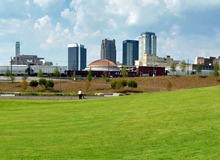A Downtown Park, a PR Opportunity
Posted At: March 28, 2011 2:22 PM
by Wesley Vaughn
 Even before it opened on Sept. 17, 2010, Birmingham’s Railroad Park was labeled a symbol of progress and hope in a city that has faced unfavorable public perception since the civil rights movement of the 1960s. The 20-acre green space served as an urban planning achievement, but it has also served as a launching point and spark for Birmingham’s public image revitalization.
Even before it opened on Sept. 17, 2010, Birmingham’s Railroad Park was labeled a symbol of progress and hope in a city that has faced unfavorable public perception since the civil rights movement of the 1960s. The 20-acre green space served as an urban planning achievement, but it has also served as a launching point and spark for Birmingham’s public image revitalization.
Most major downtown areas have a natural space that provides an escape from the urban environment. New York City has Central Park, Atlanta has Centennial Olympic Park and Chicago has Millennium Park. Now, Birmingham can boast the same with the debut of Railroad Park.
Though the Magic City would like to attract new residents and businesses to the city, it also needs to target its current residents. Many still do not hold the greatest admiration for the city and believe it trails behind other major southeastern cities. This park could help reverse that mood.
“Birmingham as a region has historically suffered from low self-esteem,” Birmingham Business Alliance Associate Media Editor Tatiana Richards said. “Essentially, we’ve had a negative self-image.”
That negative self-image stems from embarrassing rankings, such as US News & World Report listing Birmingham as the third most dangerous city in America. A litany of failed projects and corrupt politicians have contributed to this poor reputation as well.
Railroad Park represents a new hope for the area and has kicked off downtown revitalization.
“This is a game changer for Birmingham,” Railroad Park Executive Director Billmeier told Birmingham Magazine. “It’s only a matter of time before this whole blighted industrial area, as well as the entire city, is changed significantly.”
What a park can lead to
The BBA, a nonprofit organization that focuses on economic growth in the Birmingham region, attempted to capitalize on the momentum spurred from Railroad Park by introducing Blueprint Birmingham at the park less than a week after the park opened in September.
Blueprint Birmingham is a long-term strategic plan for the region crafted by major stakeholders and urban planners. As a public-private partnership, the plan calls for those in both the public and the private sectors to help achieve its objectives. Revealing the plan at Railroad Park worked to legitimize both the plan and the optimism generated by the park.
“Railroad Park was instrumental in connecting the community with Blueprint Birmingham,” Richards said. “It was perfect timing. The crowd was a microcosm of the community and was exactly who we wanted to reach.”
In November, Birmingham Mayor William Bell announced plans for the downtown return of the city’s minor-league baseball team, the Birmingham Barons. The Barons, which moved to the suburb of Hoover in 1988, would play in a proposed ballpark close to Railroad Park.
The Community Foundation of Greater Birmingham announced and began thePrize2theFuture competition in January at Railroad Park. The competition will award a cash prize to the individual or group with the best idea for what the city-owned lot next to park should become.
“Our history and our value is to listen to the community, so Prize2theFuture is an extension of that,” said Emily Rushing, director of communications for the foundation. “By using an online platform, we were seeking a way to listen to the best ideas from everywhere, especially our own community.”
Furthermore, the Railroad Park Foundation itself raises money to host events and acts as a self-advocate. Other nonprofits and city leaders are working on redeveloping the other spaces surrounding the park to further accentuate the area.
All of the aforementioned projects and others not mentioned exemplify a collaborative public relations effort of nonprofits, local government and residents of Birmingham. In the field of urban public relations, more than one organization shares the goal of improving an area as much as possible. Thus, cooperation is a must.
“No one can make transformational change without partners,” Rushing said.
A park as a part of a community
For metropolitan PR practitioners, understanding that something like a park represents another piece in a city’s ongoing narrative is essential. Wade Kwon, a Birmingham-based communications consultant and head teacher at BirminghamBlogging.com, explained how Railroad Park fits into the story of Birmingham.
“In other cities, this would be just another park,” Kwon said. “For this city, it’s a starting point in the long road to fulfilling the long-standing promise we believe in.”
Engaging the community throughout this entire process is a must, and the public relations of the various groups involved can connect a city’s progress to its community. A poor perception can be combated through effective promotion and explanation of significant advances.
“The community must be involved at all levels at all times,” Kwon said. “No one group can take credit.”
Birmingham is staging a revival. With the opening of Railroad Park and collaboration among various forces, the city has a chance to build off of its latest major success. This goal cannot be accomplished without strong PR strategies.
Shortly after the park opened, Giles Perkins, president emeritus of Railroad Park Foundation board of directors decreed, “Let the Railroad Park be the spark that sets Birmingham on fire.”
PR practitioners are tasked with stoking that fire by delivering a clear, collaborative message and by ensuring that its flames carry through the entire community.
“Photo courtesy of Bhamwiki”


